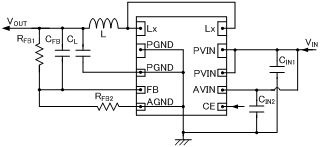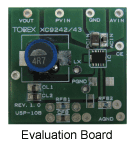2A Synchronous Step-Down DC/DC Converters
The XC9242 series is a group of synchronous-rectification step-down DC/DC converters with a built-in 0.11Ω(TYP.) P-ch MOS driver transistor and 0.12Ω(TYP.) N-ch MOS switching transistor, designed to allow the use of ceramic capacitors. The small on-resistances of these two internal driver transistors enable a high efficiency, stable power supply with an output current up to 2A. The XC9242 series has operating voltage range of 2.7V~6.0V and a 0.8V (±2.0%) reference voltage, and using externally connected resistors, the output voltage can be set freely from 0.9V.
With an internal switching frequency of 1.2MHz or 2.4MHz, small external components can be used.
The series have a high speed soft-start as fast as 1ms in typical for quick turn-on. It’s suitable for large-current application due to limit current is configured 4.0A in typical. During stand-by, all circuits are shutdown to reduce current consumption to as low as 1.0μA or less.
The integrated CL discharge function which enables the electric charge at the output capacitor CL to be discharged via the internal discharge switch located between the LX and VSS pins. Due to CL discharge function, malfunction on LX is prevented when Stand-by mode. With the built-in UVLO (Under Voltage Lock Out) function, the internal P-channel driver transistor is forced OFF when input voltage becomes 2.5V or lower. The series are available in USP-10B and SOP-8FD packages.
Feature
| Driver Transistor | 0.11Ω P-ch Driver Transistor 0.12Ω N-ch Switching Transistor |
| Input Voltage Range | 2.7V~6.0V |
| Output Voltage Range | 0.9V~VIN |
| FB Voltage | 0.8V±2.0% |
| High Efficiency | 95%(TYP.) |
| Output Current | 2.0A |
| Oscillation Frequency | 1.2MHz±15%,2.4MHz±15% |
| Maximum Duty Cycle | 100% |
| Functions | Soft-Start,CLDischarge,Current Limit(Automatic return),Thermal Shut Down,UVLO |
| Capacitor | Low ESR Ceramic |
| Control Methods | PWM |
| Operating Ambient Temperature | -40℃~+85℃ |
| Environmentally Friendly | EU RoHS compliant, Pb free |
Typical Application Circuit


Quality Reports
Technical Document
Packages
| Package | Number of Pins | Pcs/Reel | Package Size(mm) |
|---|---|---|---|
| USP-10B | 10 | 3,000 | 2.6 x 2.9 x 0.6 |
XC9242 Series Part Numbers
| Part number | Sample | Reference Voltage | Oscillation Frequency | Package | EDA | Online Store |
|---|---|---|---|---|---|---|
|
|
|
|
|
|
|
|
| XC9242B08CDR-G | 0.8V | 1.2MHz | USP-10B |
|
||
| XC9242B08DDR-G | 0.8V | 2.4MHz | USP-10B |
|
Inquiries About XC9242
Please wait for a while until the form is displaying.
If the form is not displaying, please contact us from inquiry form.